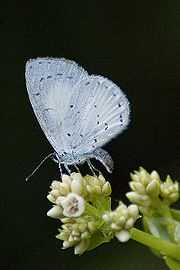Udara akasa
| White Hedge Blue | |
|---|---|
 | |
| White Hedge Blue | |
| Scientific classification | |
| Kingdom: | Animalia |
| Phylum: | Arthropoda |
| Class: | Insecta |
| Order: | Lepidoptera |
| Family: | Lycaenidae |
| Genus: | Udara |
| Species: | U. akasa |
| Binomial name | |
| Udara akasa (Horsfield, 1828) | |
| Synonyms | |
|
Akasinula akasa | |
The White Hedge Blue (Udara akasa) is a small butterfly found in India[1] that belongs to the Lycaenids or Blues family.
Taxonomy
The butterfly was earlier known as Lycaenopsis akasa.[1]
Description
Male Upperside, fore wing: black; a medial triangular area that extends from base outwards to the disc white, suffused at base and anteriorly with iridescent blue that spreads upwards on to the black of the costa; along the dorsum the black groundcolour is much paler, in most specimens diffuse fuscous. Hind wing: white, basal third and costal margin broadly suffused with fuscous, the fuscous at base posteriorly overlaid with iridescent blue; a subterminal series of fuscous-black dots and a distinct but very slender black anticiliary line. Underside : white very slightly tinged with bluish; markings all fuscous black, minute and very slender. Fore wing: a short disco-cellular line followed by on anteriorly, strongly curved, discal series of very short detached lines and a more or less obsolescent transverse series of subterminal dots. Hind wing: three subbasal dots in transverse order; a short line on the discocellulars; a spot below the middle of the costa with a smaller spot below it; a posterior discal irregular sinuous series of five or six minute spots and a perfectly regular subterminal series of similar spots. Cilia of both fore and hind wings white. Antennae, head, thorax and abdomen blackish, the antennae ringed with white ; beneath : the palpi, thorax and abdomen snow-white.
Female: Very similar. Upperside: the white area much more extended on both fore and hind wings. On the former it spreads well into the cell, on the latter three-fourths of the wing are white; the dusky basal and costal areas much more restricted than in the male. The iridescent blue suffusion is in many specimens entirely absent, in a few very faintly indicated ; the subterminal series of black dots so distinct in the male are generally faint and obsolescent. Underside: as in the male but the markings less distinct. Antennae, head, thorax and abdomen as in the male.[2]
Range
It is found in Sri Lanka and South India.[1]
See also
References
- Beccaloni, G. W., Scoble, M. J., Robinson, G. S. & Pitkin, B. (Editors). 2003. The Global Lepidoptera Names Index (LepIndex). World Wide Web electronic publication. http://www.nhm.ac.uk/entomology/lepindex [accessed 14 October 2006].
- Evans, W.H. (1932) The Identification of Indian Butterflies. (2nd Ed), Bombay Natural History Society, Mumbai, India